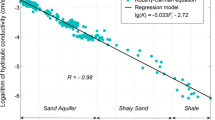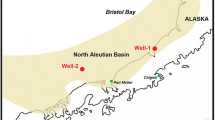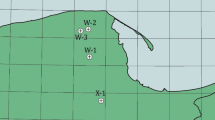Abstract
A multivariate statistical procedure is developed for the estimation of shale volume in clastic sedimentary formations. The method offers an alternative for extracting the shale content from borehole geophysical measurements. Factor analysis of various well-logging data types generates a new well log that correlates with the shale content of shaly-sandy rocks. The mathematical relationship between shale volume and factor scores is represented by a nonlinear equation, which seems to be applicable for data sets originating from different sedimentary basins. A comparative study is made between three different data sets originating from Hungary and the United States of America in order to check the validity of the proposed empirical formula. Shale volumes predicted from factor analysis are confirmed by estimates from independent deterministic and inverse modeling. Petrophysical information derived by factor analysis of logs recorded in deep wells can be used for a more accurate and reliable estimation of effective porosity and absolute permeability of reservoir rocks, for decreasing the estimation error of inversion estimates and for reducing the ambiguity in the solution of the well-logging inverse problem.







Similar content being viewed by others
References
Alberty M, Hashmy K (1984) Application of ULTRA to log analysis. In: SPWLA symposium transactions, paper Z, pp 1–17
Anna LO (2009) Geologic assessment of undiscovered oil and gas in the Powder River Basin Province, Wyoming and Montana. US Geological Survey, Reston, Virginia
Asquith GB, Krygowski DA (2004) Basic well log analysis, 2nd edn. AAPG methods in exploration series, vol 16. AAPG, Tulsa
Ball SM, Chace DM, Fertl WH (1987) The well data system (WDS): an advanced formation evaluation concept in a microcomputer environment. In: Proceedings of SPE eastern regional meeting, paper 17034, pp 61–85
Bartlett MS (1937) The statistical conception of mental factors. Br J Psychol 28:97–104
Bhuyan K, Passey QR (1994) Clay estimation from GR and neutron-density porosity logs. In: SPWLA 35th annual logging symposium, conference paper 1994-DDD
Buoro BA, Silva JBC (1994) Ambiguity analysis of well-log data. Geophysics 59:336–344
Clavier C, Hoyle W, Meunier D (1971) Quantitative interpretation of thermal neutron decay time logs: part I. Fundamentals and techniques. J Pet Technol 23:743–755
Dobróka M, Szabó NP (2005) Combined global/linear inversion of well-logging data in layer-wise homogeneous and inhomogeneous media. Acta Geod Geophys Hung 40:203–214
Dobróka M, Szabó NP (2011) Interval inversion of well-logging data for objective determination of textural parameters. Acta Geophys 59:907–934
Dobróka M, Szabó NP (2012) Interval inversion of well-logging data for automatic determination of formation boundaries by using a float-encoded genetic algorithm. J Pet Sci Eng 86–87:144–152
Dobróka M, Szabó NP, Turai E (2012) Interval inversion of borehole data for petrophysical characterization of complex reservoirs. Acta Geod Geophys Hung 47:172–184
Dobróka M, Szabó NP, Cardarelli E, Vass P (2009) 2D inversion of borehole logging data for simultaneous determination of rock interfaces and petrophysical parameters. Acta Geod Geophys Hung 44:459–482
Dolton GL (2006) Pannonian Basin Province, Central Europe (Province 4808)—petroleum geology, total petroleum systems, and petroleum resource assessment. US Geol Surv Bull 2204-B:1–47
Ellis DV, Singer JM (2007) Well logging for earth scientists, 2nd edn. Springer, Dordrecht
Fertl WH, Frost E Jr (1980) Evaluation of shaly clastic reservoir rocks. J Pet Technol 32:1641–1646
Grana G, Dvorkin J, Cibin P (2011) Factor analysis prediction of effective stress from measurable rock attributes and calibration data. First Break 29:63–72
Herron MM (1986) Mineralogy from geochemical well logging. Clays Clay Miner 34:204–213
Isaaks EH, Srivastava RM (1989) An introduction to applied geostatistics. Oxford University Press, Oxford
Jöreskog KG (2007) Factor analysis and its extensions. In: Cudeck R, MacCallum RC (eds) Factor analysis at 100: historical developments and future directions. Erlbaum, Mahwah, pp 47–77
Kaiser HF (1958) The varimax criterion for analytical rotation in factor analysis. Psychometrika 23:187–200
Larionov VV (1969) Radiometry of boreholes (in Russian). Nedra, Moscow
Lawley DN, Maxwell AE (1962) Factor analysis as a statistical method. Statistician 12:209–229
Ma YZ (2011) Lithofacies clustering using principal component analysis and neural network: applications to wireline logs. Math Geosci 43:401–419
Mayer C, Sibbit A (1980) GLOBAL, a new approach to computer-processed log interpretation. In: Proceedings of 55th SPE annual fall technical conference and exhibition, paper 9341, pp 1–14
Menke W (1984) Geophysical data analysis: discrete inverse theory. Academic Press, New York
Poupon A, Gaymard R (1970) The evaluation of clay content from logs. In: SPWLA 11th annual logging symposium, conference paper 1970-G
Rao BN, Pal PC (1980) Factor analysis for interpreting petrophysical data on Roro ultramafics, Singhbhum District, India. Geophys Prospect 28:112–118
Serra O (1984) Fundamentals of well-log interpretation: the acquisition of logging data. Elsevier, Amsterdam
Spearman C (1904) The proof and measurement of association between two things. Am J Psychol 15:72–101
Stieber SJ (1970) Pulsed neutron capture log evaluation—Louisiana Gulf Coast. In: SPE fall meeting AIME, conference paper 2961-MS
Szabó NP (2011) Shale volume estimation based on the factor analysis of well-logging data. Acta Geophys 59:935–953
Szabó NP (2012) Dry density derived by factor analysis of engineering geophysical sounding measurements. Acta Geod Geophys Hung 47:161–171
Szabó NP, Dobróka M, Drahos D (2012) Factor analysis of engineering geophysical sounding data for water saturation estimation in shallow formations. Geophysics 77:WA35–WA44
Urbancic T, Bailey RC (1988) Statistical techniques applied to borehole geophysical data. Geophys Prospect 36:752–771
Acknowledgements
The described work was carried out as part of the TÁMOP-4.2.1.B-10/2/KONV-2010-0001 project in the framework of the New Hungary Development Plan. The realization of this project is supported by the European Union, cofinanced by the European Social Fund. The first author thanks the support of the János Bolyai Research Fellowship of the Hungarian Academy of Sciences. As a member of the MTA-ME Applied Geoscience Research Group, the second author is grateful for the support of the Hungarian Academy of Sciences. The authors express their thanks to Minnelusa.com for permitting the use of their data set.
Author information
Authors and Affiliations
Corresponding author
Rights and permissions
About this article
Cite this article
Szabó, N.P., Dobróka, M. Extending the Application of a Shale Volume Estimation Formula Derived from Factor Analysis of Wireline Logging Data. Math Geosci 45, 837–850 (2013). https://doi.org/10.1007/s11004-013-9449-2
Received:
Accepted:
Published:
Issue Date:
DOI: https://doi.org/10.1007/s11004-013-9449-2




